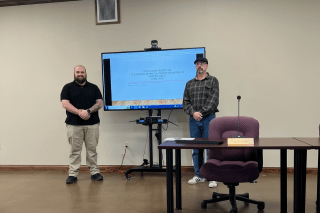Police departments from Bloomsburg University and Town of Bloomsburg awarded $33,000 grant for training program
Posted:

The Bloomsburg University Police Department will partner with the Town of Bloomsburg Police Department to implement ICAT (Integrating Communications, Assessment and Tactics) training for all officers in Bloomsburg and surrounding areas.
The training will be paid for with a $33,000 grant to the Town police through the Arconic Foundation. The training will take place at Monty's on BU's Upper Campus on Tuesday and Wednesday, July 12-13, from 8 a.m. to 4 p.m.
Since 2008, the Arconic Foundation has provided over $1.8 million to nonprofit and community organizations in and around the Bloomsburg area that focus on enhancing education, promoting environmental sustainability, and advancing social equity. Kawneer, located in Bloomsburg, is part of Arconic Corporation which operates 21 manufacturing sites throughout the world.
Integrating Communications, Assessment, and Tactics, or ICAT, is a use-of-force Training Guide designed to fill a critical gap in training police officers in how to respond to volatile situations in which subjects are behaving erratically and often dangerously but do not possess a firearm. The Training Guide includes model lesson plans and support materials in decision-making, crisis recognition and response, tactical communications and negotiations, and operational safety tactics. ICAT then integrates these skills and provides opportunities to practice them through video case studies and scenario-based training exercises.
ICAT was developed by the Police Executive Research Forum (PERF) to provide officers with the mindset, skills, and abilities to effectively defuse volatile incidents in a crisis situation. The results of ICAT were empirically validated by Dr. Robin Engle, University of Cincinnati Research Institute, in a stepped wedge research analysis in Louisville (Louisville Metro Police) which demonstrated significant reductions in officer injuries, citizen injuries and complaints.
The ICAT Training Guide focuses on four key areas:
- Patrol officer response. In almost every situation where a subject is behaving erratically (often because of mental illness or behavioral crisis), a patrol officer- a "beat cop" - is the first to respond. ICAT provides these officers with the skills and options needed to safely and effectively manage these encounters, especially in the critical first few moments after officers arrive. In many instances, the goal is for the first responding officers to buy enough time so that additional, specialized resources can get to the scene to support a safe and peaceful resolution.
- Non-firearms incidents. ICAT focuses on those critical incidents in which the subject is unarmed or armed with a weapon other than a firearm (such as a knife, baseball bat, rocks, or other blunt instruments). Unlike situations in which the subject has a firearm and officers have few options besides lethal force, these non-firearms incidents often present officers with time and opportunity to consider a range of responses.
- Integration of crisis recognition/intervention, communications, and tactics. In recent years, a growing number of police agencies have provided their officers with specialized training on how to interact with persons who are in crisis because of mental health issues or other factors. ICAT builds on those efforts by integrating communications and tactical skills with crisis intervention approaches. A Critical Decision-Making Model helps patrol officers develop and think through their options in challenging non-firearms incidents.
- Officer safety and wellness. ICAT is centered on PERF's Guiding Principle #1: "The sanctity of human life should be at the heart of everything an agency does." The Training Guide focuses on protecting officers from both physical threats and emotional harm. This is accomplished by equipping officers with the tools, techniques and skills needed to slow down some situations and pursue options for safely resolving them. The goal is to help officers avoid reaching the point where their lives or the lives of others become endangered and the officers have no choice but to use lethal force.


